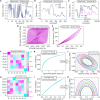One for all: Universal material model based on minimal state-space neural networks
- PMID: 34162539
- PMCID: PMC8221615
- DOI: 10.1126/sciadv.abf3658
One for all: Universal material model based on minimal state-space neural networks
Abstract
Computational models describing the mechanical behavior of materials are indispensable when optimizing the stiffness and strength of structures. The use of state-of-the-art models is often limited in engineering practice due to their mathematical complexity, with each material class requiring its own distinct formulation. Here, we develop a recurrent neural network framework for material modeling by introducing "Minimal State Cells." The framework is successfully applied to datasets representing four distinct classes of materials. It reproduces the three-dimensional stress-strain responses for arbitrary loading paths accurately and replicates the state space of conventional models. The final result is a universal model that is flexible enough to capture the mechanical behavior of any engineering material while providing an interpretable representation of their state.
Copyright © 2021 The Authors, some rights reserved; exclusive licensee American Association for the Advancement of Science. No claim to original U.S. Government Works. Distributed under a Creative Commons Attribution NonCommercial License 4.0 (CC BY-NC).
Figures



References
-
- Si X., Hu C., Zhang J., A review of recurrent neural networks: Lstm cells and network architectures. Neural Comput. 31, 1235–1270 (2019). - PubMed
-
- Sutskever I., Vinyals O., Le Q. V., Sequence to sequence learning with neural networks. Adv. Neural Inf. Process. Syst. 4, 3104–3112 (2014).
-
- R. Pascanu, C. Gulcehre, K. Cho, Y. Bengio, How to construct deep recurrent neural networks, in Proceedings of the 2nd International Conference on Learning Representations (ICLR 2014) (2014), pp. 1–13.
-
- Bengio Y., Simard P., Frasconi P., Learning long-term dependencies with gradient descent is difficult. IEEE Trans. Neural Netw. 5, 157–166 (1994). - PubMed
-
- Hochreiter S., Urgen Schmidhuber J., Long short-term memory. Neural Comput. 9, 1735–1780 (1997). - PubMed
LinkOut - more resources
Full Text Sources

